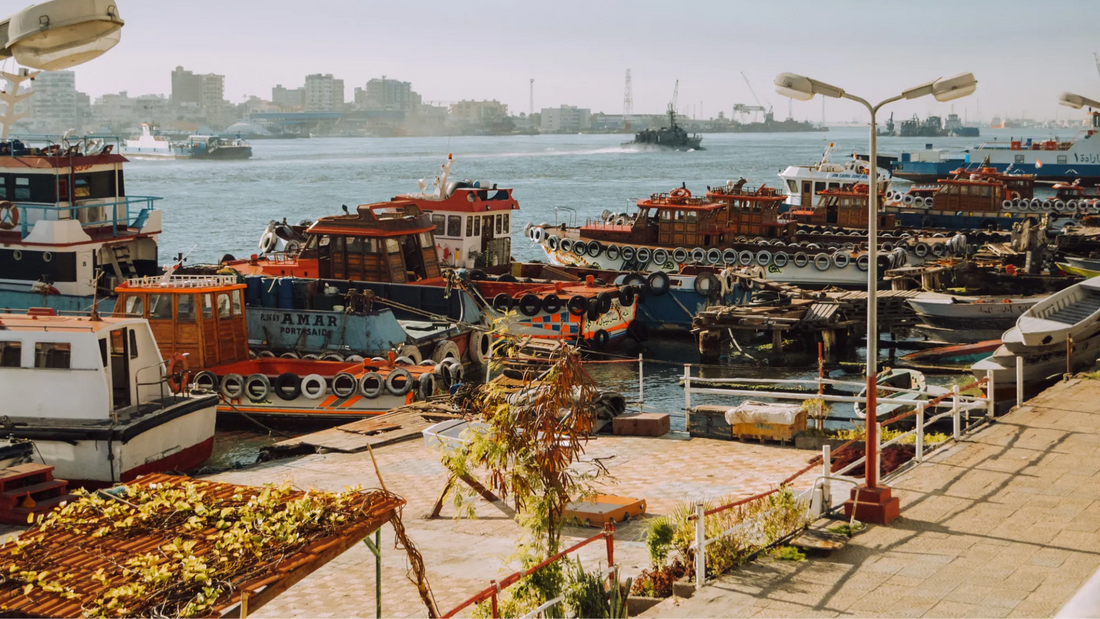
Share
Exploring the Heritage of the Suez Canal and the Simsimiyya Dance
On September 20th, during my performance at The Cultch in Vancouver, I had the privilege of witnessing a traditional dance rooted in the Suez Canal region. The performance embodied the soul of the Canal’s working-class roots and its historical evolution. This experience inspired me to dive deeper into the history of the region and the dance that emerged from it.

Simsimiyya is associated with a dance, a music style, and a muscial instrument. The Simsimiyya dance is a traditional Egyptian dance that developed from various cities in the Suez Canal region, primarily Ismailia, Suez, and Port Said. The music and dance associated with Simsimiyya captures the essence of these cities, featuring variations such as Bambouti, which originates from Port Said, Malhoul from Ismailia, and Kef that is performed during pre-wedding ceremonies in Suez.

The Founding of the Suez Canal
The Suez Canal, an engineering marvel, began construction in 1859 and opened in 1869, connecting the Mediterranean Sea to the Red Sea. This monumental project forever changed global trade and navigation, allowing ships to travel between Europe and Asia without the lengthy journey around Africa. The canal's construction fostered economic growth across the canal cities of Suez, Ismailia, and Port Said.

As the canal opened, these cities became bustling centers of commerce and trade, attracting workers, administrators, and traders from Egypt and beyond. The influx of diverse cultures and communities contributed to a rich landscape where music and dance flourished. Among these, Simsimiyya emerged, rooted in the working-class communities of the canal region.

British Occupation and National Resistance
In 1882, British forces occupied Egypt, using Port Said as their point of entry. This occupation lasted for decades, leaving lasting cultural and political impacts to the region and the country as a whole. During the long period of British presence, nationalism flourished, where local Suez resistance movements found their voice with the Simsimiyya music.

British control of the canal continued until the mid-20th century, when the canal was nationalized under President Gamal Abdel Nasser, seizing control from British and French interests. This decision triggered a military intervention by Britain, France, and Israel, sparking the infamous Suez Crisis in 1956. Despite the short-lived invasion, Egypt’s resistance during the crisis became a defining moment in the nation's history.

The Birth of Musical Traditions
During the construction of the Suez Canal, workers from various regions of Egypt brought their own musical influences, leading to the development of a unique local sound. The workers would spend the night, after their work shifts, at damma gatherings. At the gatherings, musicians and singers sat in circles, typically playing simple instruments like the tabla drum, spoons, and occasionally a tambourine. The themes of their songs often revolved around love, religious devotion, and daily life. Over time, this music evolved into a distinct style, marking the early roots of the music we recognize today.

Among the instruments, the simsimiyya, a smaller version of an instrument known as the tamboura from Aswan, emerged as a hallmark of urban music in Port Said, Suez, and Ismailia. This stringed instrument soon became emblematic of nationalistic pride, with its music serving as a means for local communities to express resistance against foreign dominance. Simsimiyya united people in their struggle for liberation, with its communal performances symbolizing the resilience of Egypt's working class.

Dance Characteristics
When large foreign ships sailed the Suez Canal, Egyptian merchants on small feluccas, Egyptian sail boats, would jump and wave their arms to attract attention and sell their goods. The dance that developed mirrored the numerous jumps and movements of the canal merchants, as well as the laborers and local fishermen.

The Simsimiyya dance features cheerful steps where the front leg moves forward and back, while the back leg rises and falls. This movement is coordinated with hip movements and hand gestures. Men's performances often feature impressive jumps, inspired by the workers of Port Said, as seen in the Bamouti style, whereas women's performances usually highlight hip movements. A unique element of the dance is the use of spoons for rhythm, adding a distinctive flair to the performance.

Costumes
The costumes worn in the dance reflect the stylized clothing of various groups of workers, including fishermen, coastguards, and sailors. These garments not only enhance the visual appeal of the performance but also connect the dancers to the dance's roots and traditions.

Men often wear striped shirts, usually in blue and white or black and white, symbolizing the attire of sailors and fishermen. These shirts are generally paired with loose-fitting trousers. The look is often completed with sailor caps or headwraps.

For women, costumes can vary depending on the performance style. Traditionally women wore long colorful robes with a headscarf. In many modern performances, women’s outfits may feature brighter colors and a more festive appearance. Some women also incorporate sailor-themed elements, like striped tops or sailor hats, mirroring the men's costumes and emphasizing the coastal heritage of the dance.

Cultural Significance
Simsimiyya is more than a traditional art form; it is an embodiment of cultural resilience and pride, where it became a symbol of community and solidarity during periods of hardship and resistance. During the Suez Crisis, the music took on a deeper meaning as they became a cultural rallying cry, representing the struggle against colonial forces and the fight for national sovereignty. The use of simple instruments like spoons and the collective nature of the dance reflect the shared experiences of the region’s people.

A Living Legacy
Today, the Simsimiyya dance continues to preserve the history and spirit of the Suez region, acting as a living testament to the enduring heritage of the Suez Canal. The unique blend of history, culture, and dance showcase the power of community and tradition, making it a captivating subject for exploration and appreciation. The performance I saw was a beautiful reminder of how these traditions can be embraced and celebrated across different cultures, paying homage to the heritage of the Suez Canal region.

